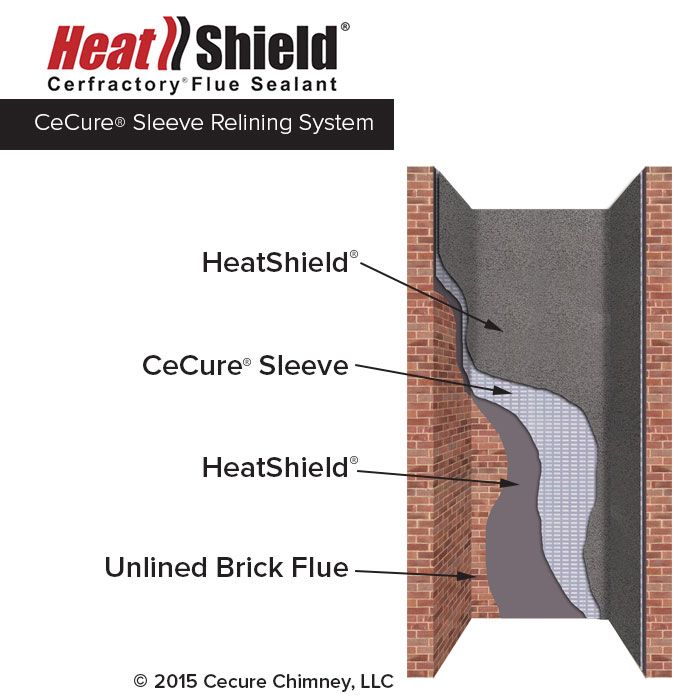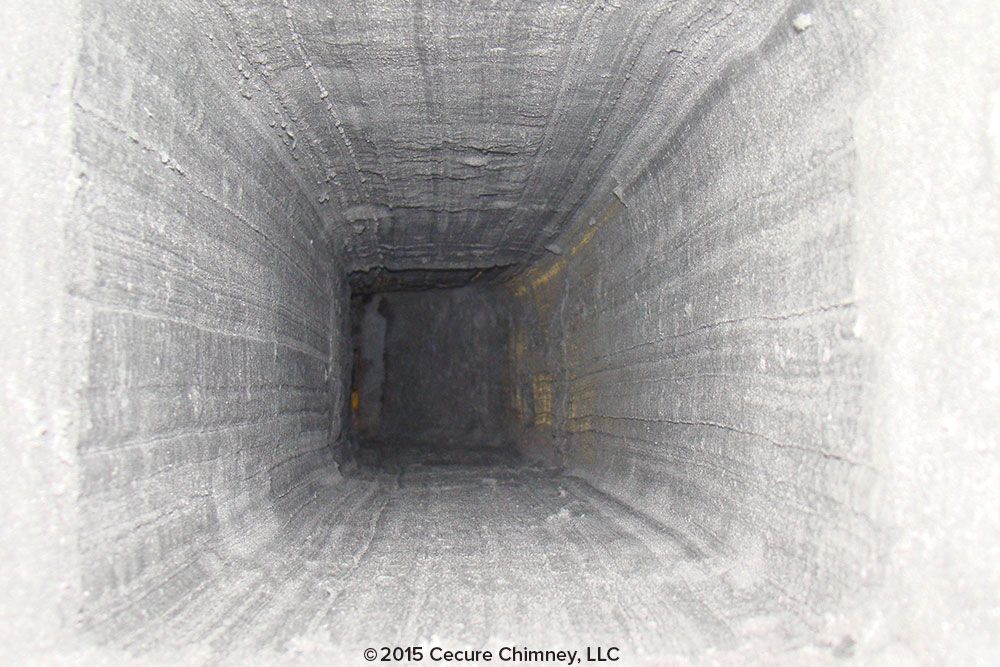FACTS
ON FURNACE FLUE LINER IN MASONRY CHIMNEYS
A furnace flue liner in a masonry chimney is a protective layer inside the chimney that prevents the release of harmful gases into the living space. Here are some facts about furnace flue liners in masonry chimneys:
- Furnace flue liners are typically made from clay tile, stainless steel, or cast-in-place concrete.
- The purpose of a furnace flue liner is to protect the chimney walls from the heat, moisture, and corrosive byproducts of combustion.
- A properly installed furnace flue liner can help improve the efficiency of your furnace and reduce the risk of carbon monoxide poisoning.
- Building codes require that all masonry chimneys have a furnace flue liner installed.
- The size of the furnace flue liner should be matched to the size of the furnace to ensure proper ventilation.
- A furnace flue liner should be inspected annually and replaced if there are any signs of damage or deterioration.
- It is important to hire a licensed professional to install or replace a furnace flue liner to ensure proper installation and compliance with building codes.
- A furnace flue liner should be cleaned regularly to prevent the buildup of creosote and other combustible materials.
- A damaged or improperly installed furnace flue liner can lead to a chimney fire, carbon monoxide poisoning, or other safety hazards.
- If you are unsure about the condition of your furnace flue liner or chimney, it is recommended to have a professional inspection done to ensure the safety of your home and family.

FACTS
ON SMOKE CHAMBERS IN MASONRY CHIMNEYS
A smoke chamber is an important component of a masonry chimney that connects the fireplace opening to the flue. Here are some facts about smoke chambers in masonry chimneys:
- The smoke chamber is the area above the fireplace and below the flue that helps to direct smoke and gases up and out of the chimney.
- The design of the smoke chamber is critical to the proper operation of a masonry chimney, as it helps to prevent downdrafts and reduce the buildup of creosote.
- Smoke chambers are typically constructed from masonry materials such as brick or stone.
- The shape of the smoke chamber should be smooth and curved to help prevent the accumulation of soot and creosote.
- Smoke chambers should be insulated to help prevent heat transfer to the surrounding masonry and reduce the risk of chimney fires.
- Building codes require that smoke chambers be at least 8 inches deep and that the walls be no less than 4 inches thick.
- It is important to have a professional inspect your smoke chamber and chimney regularly to ensure that they are in good condition and functioning properly.
- If your smoke chamber is damaged or poorly constructed, it can lead to poor chimney performance, increased creosote buildup, and an increased risk of chimney fires.
- Smoke chambers should be cleaned regularly to remove any soot or creosote buildup and to ensure proper airflow.
- If you are experiencing problems with your chimney, such as excessive smoke or poor draft, it may be due to a problem with your smoke chamber, and you should contact a professional for an inspection and any necessary repairs.
FACTS
ON GAS BURNING FIREPLACE FLUES IN MASONRY CHIMNEYS
Gas burning fireplaces are becoming increasingly popular in homes, and they typically require a flue in a masonry chimney to vent the exhaust gases outside. Here are some facts about gas burning fireplace flues in masonry chimneys:
- Gas burning fireplaces are often used as a more convenient and efficient alternative to wood-burning fireplaces.
- The exhaust gases from gas burning fireplaces contain carbon monoxide, which can be dangerous if not properly vented.
- Gas burning fireplaces require a properly sized flue in the masonry chimney to ensure proper ventilation of the exhaust gases.
- The size of the flue should be matched to the size of the fireplace to ensure proper ventilation and prevent the buildup of carbon monoxide.
- Gas burning fireplaces may require different types of flue liners than wood-burning fireplaces, depending on the type of gas being used and the specific design of the fireplace.
- The flue liner for a gas burning fireplace should be made from a material that is resistant to corrosion and heat damage.
- It is important to have a professional install the flue liner and any other components of the gas burning fireplace to ensure that they are properly installed and comply with local building codes.
- The flue liner for a gas burning fireplace should be inspected and cleaned regularly to prevent the buildup of creosote and other debris that can block the flow of exhaust gases.
- The use of a gas burning fireplace should be accompanied by a carbon monoxide detector to ensure that any dangerous levels of carbon monoxide are detected and addressed.
- If you are considering installing a gas burning fireplace in your home or have concerns about the performance of an existing gas burning fireplace flue in your masonry chimney, it is recommended that you consult with a professional to ensure that your fireplace is safe and properly installed.
FACTS
ON WOOD BURNING FIREPLACE FLUES IN MASONRY CHIMNEYS
A wood burning fireplace typically requires a flue in a masonry chimney to vent the exhaust gases outside. Here are some facts about wood burning fireplace flues in masonry chimneys:
- The flue is a vertical channel in a masonry chimney that carries smoke and other gases from a wood burning fireplace to the outside.
- The size of the flue should be matched to the size of the fireplace to ensure proper ventilation and prevent the buildup of creosote.
- The flue liner for a wood burning fireplace should be made from a material that is resistant to heat and corrosion, such as clay tile or stainless steel.
- The flue liner for a wood burning fireplace should be inspected and cleaned regularly to prevent the buildup of creosote and other debris that can block the flow of exhaust gases.
- The height of the flue should be sufficient to create a draft that pulls smoke and other gases up and out of the chimney.
- The chimney cap, which covers the top of the chimney, helps to prevent debris from entering the flue and blocking the flow of gases.
- Building codes require that wood burning fireplaces have a spark arrester, which helps to prevent embers from escaping the fireplace and starting a fire in the surrounding area.
- The use of a wood burning fireplace should be accompanied by a carbon monoxide detector to ensure that any dangerous levels of carbon monoxide are detected and addressed.
- It is important to have a professional inspect your wood burning fireplace flue and chimney regularly to ensure that they are in good condition and functioning properly.
- If you are experiencing problems with your wood burning fireplace, such as excessive smoke or poor draft, it may be due to a problem with your flue or chimney, and you should contact a professional for an inspection and any necessary repairs.
FACTS
ON GLAZED CREOSOTE
Glazed creosote is a highly flammable and dangerous substance that can form in chimneys and stovepipes that burn wood. Here are some facts about glazed creosote:
- Creosote is a byproduct of burning wood, and it can accumulate in chimneys and stovepipes over time.
- Creosote is highly flammable, and if it ignites, it can cause a chimney fire.
- Glazed creosote is a hardened and highly concentrated form of creosote that is difficult to remove and highly flammable.
- Glazed creosote can form when creosote is exposed to high temperatures over a long period of time, causing it to harden and create a shiny or glass-like surface.
- Glazed creosote can be difficult to remove and can require special tools and equipment to break it up and remove it from the chimney or stovepipe.
- The best way to prevent glazed creosote from forming is to burn dry, seasoned wood, and to maintain proper airflow in the chimney or stovepipe.
- Burning smaller, hotter fires can also help to prevent the buildup of creosote in the chimney or stovepipe.
- Regular chimney inspections and cleanings by a professional can help to identify and remove any creosote buildup, including glazed creosote.
- If you suspect that you have glazed creosote in your chimney or stovepipe, do not use your fireplace or stove until it has been inspected and cleaned by a professional.
- Glazed creosote is a serious fire hazard, and it is important to take steps to prevent its formation and to have any buildup removed as soon as possible to ensure the safety of your home and family.
Phone: 206-579-3579 | Email: starbrightchimney01@gmail.com | Business Hours: Monday - Friday: 6:00 AM – 6:00 PM | Saturday & Sunday: Weekends By Appointment Only



